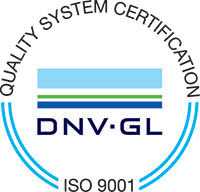Delstar recognized some time ago that the creation and implementation of nationally accepted standards regarding electropolished finishes was desperately needed in order to establish and maintain quality. Working closely with an independent research institute, our research and development teams led the industry's response to this challenge by establishing the Electropolish Finish Standards (EFS). Each standard contains specifications in order to enable customers to accurately specify the final finish desired.
EFS-1 (Critical Applications Requiring Surface Verification)
Part is to be pre-cleaned if necessary, and electropolished to uniform overall finish with maximum brightness, luster and reflectivity on required surfaces as shown by symbol on print. If indicated, final finish must be to the Ra or RMS finish noted.
Specified electropolished surfaces to be free of frosting, shadows, streaks, erosion, stains, water spots and irregular patterns in the finish. Specified surfaces also to be free of pebbly, orange peel or pitted appearance.
Part is to be cleaned to acid-free condition throughout, D.I. water rinsed, dried and packaged to protect the electropolished surface. Surface shall be confirmed by one or more standard surface quality tests specified below.
- EFS-1a (Verification by SEM Photomicroscopy)
Electropolisher to provide photomicrographs (100x and 1,000X magnification) of representative surface areas to assure maximum electropolished surface condition. Surface will show no evidence of grain boundaries. - EFS-1b (Verification by Auger Electron Spectroscopy)
Electropolisher to provide results of Auger Electron Spectroscopy (AES) taken from representative surface areas to assure maximum electropolished surface condition. Depth of chrome oxide layer shall not be less than 20 Å (Angstroms). - EFS-1c (Verification by ESCA Analysis)
Electropolisher to provide results of Electron Spectroscopy for Chemical Analysis (ESCA) taken from representative surface areas to assure that the maximum electropolished condition has been achieved. ESCA will be conducted in tandem with AES to confirm the quality of the Cr/Fe oxide profile.
EFS-2 (Critical Applications Not Requiring Surface Verification)
Part is to be pre-cleaned if necessary, and 100 percent electropolished to uniform overall finish with maximum brightness, luster and reflectivity on required surfaces as shown by symbol on print. If indicated, final finish must be to the Ra or RMS finish noted. Specified electropolished surfaces to be free of frosting, shadows, streaks, erosion, stains, water spots and irregular patterns in the finish. Specified surfaces also to be free of pebbly, orange peel or pitted appearance. Part is then to be cleaned to acid-free condition throughout, D.I. water rinsed, dried and packaged to protect the electropolished surface.
EFS-3 (Technical Applications Allowing Variations in Finish)
Where an EFS-2 electropolished surface is not required and where a more economical electropolishing finish is acceptable, the following specification can be used. Less stringent than the one above, this specification will allow some irregularities in the finish.
Part to be pre-cleaned if necessary, and bright electropolished to a visually uniform finish on required surfaces as designated by symbol on print. Specified electropolished surfaces must be free of pebbly, orange peel or pitted appearance. Part is then to be cleaned to an acid-free condition throughout.
EFS-4 (Non-Reflective Applications)
An EFS-4 electropolished finish is used where a non-reflective surface is required.
Part to be pre-cleaned if necessary, and electropolished to a uniform satin finish. Surfaces shall exhibit no bright, reflective areas and shall be free of pebbly, orange peel or pitted appearance. Part is to cleaned to an acid-free condition throughout.
EFS-X (Specification for Electrical Connection to Part)
Where location of "rack marks" or other evidence of DC power anode contact is important, the following specification should be included:
Electrical anode connections to part shall be at those points or within those areas indicated on the part drawing, or at alternate locations as approved by Purchaser.
Special Note
Specifications should be included in any written description of work as well as on the part drawing. The electropolishing specification should be a part of, and in addition to, any required mechanical polishing specification. Special post-electropolishing cleaning and/or packing instructions should also be included.
Other Recognized Electropolishing Standards and Specifications
- ASME BPE Standards for Electropolishing Bioprocessing Equipment
- SEMI F19, Electropolishing Specifications for Semiconductor Applications
- ASTM B 912, Passivation of Stainless Steels Using Electropolishing
 Delstar
Delstar
